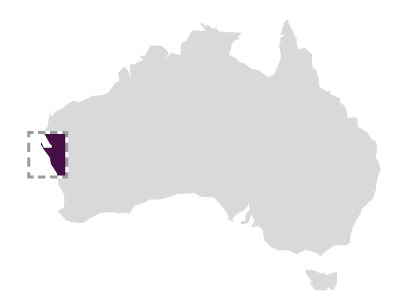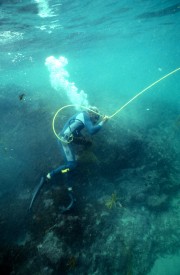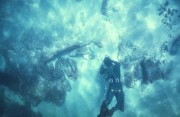Zuytdorp (1712/06/09)
North of Kalbarri

This is the only ship that needs permission to dive on in WA. Protected zone 500 m around wreck.
On 1 August 1711, Zuytdorp (meaning ‘South village’) was dispatched from the Netherlands to the trading port of Batavia. It never arrived at its destination. No search was undertaken, since there was no idea where the ship was lost. The crew were never heard from again.
In 1834, Aboriginal people told a farmer from near Perth about a wreck some distance to the north. With references to a wreck and coins on the beach, details strongly pointed to the Zuytdorp, however the colonists presumed it was a recent wreck and sent rescue parties who failed to find the wreck or any survivors.
Between 1926 and 1927 members of the Mallard, Drage and Pepper families who lived and worked in the area discovered wreckage from a ship along the shore and cliffs between Tamala and Murchison House Stations. Tom Pepper, Tamala Station’s head stockman, had married Lurlie Mallard, an Aboriginal woman. Tom, Lurlie, her sister Ada Drage and Ada’s husband Ernest found coins (some dated 1711), bottle fragments, timber (including a spar and a carved female figure) and breech blocks from swivel guns. They also found evidence of a deliberately lit fires, atop and at the foot of the cliffs. In 1954 following advice from Tom Pepper, a geologist, Phillip Playford, travelled to the area and viewed the site. The remains indicated that some survivors had got ashore from a then unknown wreck. In lying on the coast between two major Aboriginal encampments Wale Well to the north on Tamala Station and Billiecuthera Well to the south east on Murchison House Station, it was thought that the survivors may have joined the tribes that travelled between those two centres.
Phillip Playford was subsequently involved in a number of privately sponsored expeditions to the site, though at all times he and his companions were prevented from diving by the swells and the treacherous and extremely dangerous conditions offshore. Excavations were conducted and Playford subsequently produced a report describing and identifying the site mainly from the coins dated 1711. This was published by the Royal Western Australian Historical Society. In 1964 a team led by Geraldton identity Tom Brady, including Graham and Max Cramer, conducted the first dive on the wreck, and on a subsequent dive later found a veritable 'carpet of silver'. This discovery was followed by many other dives, including those by the Underwater Explorer's Club, the Royal Australia Navy and by the controversial salvage diver Alan Robinson. Many injuries resulted and some of the accidents nearly proved fatal.
In 1969, the Western Australian Museum became responsible for the site and it commenced the recovery of the silver under the leadership of Harry Bingham. After 1971 the programme was led by Jeremy Green, with Geoff Kimpton (one of Bingham’s team) as his chief diver. A caretaker, responsible for site security and a weather watch (there are only ever a few days per year where diving is possible) was established in quarters adjacent the site. Infrastructure in the form of a large flying fox erected on the cliffs was provided by the then owner of Murchison House Station, Prince ‘Jah’ the former Nizam of Hyderabad. This led to a number of very successful recoveries.
In 1976, the wreck was protected under the terms of the Commonwealth Historic Shipwrecks Act and under the terms of that Act a restricted zone was declared around the site. This prohibits all bar bona fide visitation to the site. There appears to have been considerable unauthorised looting of the site on occasions when the weather allowed diving nonetheless. In 1981 the dangers of the site, in water, on the land, (including in the air due to a very dangerous airstrip) and human factors (including the firebombing of the caretaker's quarters) led to the programme being shelved and a resident abalone diver appointed watchkeeper.
In 1986, the Museum's programme was resurrected under the leadership of Dr M. McCarthy concentrating as much on the social elements of the tragedy as it did on the recovery of what little remained of the silver and other objects. It also looked towards the production of a site plan designed to examine theories about the wrecking and the possibility that survivors had got ashore. The expanded programme also focussed on the possible movement of survivors away from the wreck site and on the archaeological examination of the survivor's camps for evidence of intermingling with Indigenous people. This element involved many specialists including anthropologists, prehistorians, historical archaeologists and an expert metal detector operator.
In 1986, Phillip Playford was invited to join the team with the express purpose of providing his knowledge and expertise to the Museum and of writing a popular book on the subject to add to his earlier academic works.
In 1994, a parliamentary select committee chaired by the Hon. P. G. Pendal, MLA, met in order to formally credit all who were involved in locating the British ship Tryall or Trial and the Dutch East Indiamen Batavia, Vergulde Draeck (Gilt Dragon), Zuytdorp and Zeewijk. Many submissions were received from those who felt that they, or their deceased relatives, had a role in the discoveries. In using the term ‘to discover’, i.e. to ‘find out or become aware of, whether by research or by chance’, the Committee in its report differentiated between ‘Primary Discoverers’, those whose research led to the finding of a wreck, or were ‘physically involved in the act of discovery’, and ‘Secondary Discoverers’, those whose involvement, in the committee’s opinion, was ‘resultant’, ‘consequential’, ‘subordinate’ or ‘supporting’. The distinction between Primary and Secondary Discoverers as defined in the Pendal Committee Report was significant because ex gratia payments were awarded to those Primary Discoverers still living. In 1997, amendments to the Maritime Archaeology Act 1973 (WA) were enacted, containing a ‘Register of discoverers of ancient shipwrecks’ with the intent of ‘providing statutory recognition of the discoverers’ (see section 24 and the Third Schedule of the 1973 Act as amended). The Pendal Committee’s findings recognised the discoverers of Zuytdorp in the following manner: that Tom Pepper and Phillip Playford should be regarded as primary discoverers, and that Ada Drage, Max Cramer, Graham Cramer and Tom Brady should also be recognised as secondary discoverers.
In 2007, following a submission by the Drage family, and a supporting recommendation from the Western Australian Museum’s Maritime Archaeology Advisory Committee, the Western Australian Government formally recognised Ada and Ernest Drage as additional primary discoverers.
Ship Built
Owner VOC
Master Marinus Wijsvliet
Builder VOC
Country Built Netherlands
Port Built Zeeland probably Vlissingen
Port Registered Netherlands
When Built 1701
Ship Lost
Grouped Region Mid-West
Sinking On cliffs
Crew 200-250
Deaths 200-250
When Lost 1712/06/09
Where Lost North of Kalbarri
Latitude -27.186114
Longitude 113.936453
Position Information GPS SkyView
Port From Wielingen
Port To Batavia
Cargo Coins, general cargo
Ship Details
Engine N
Length 54.30
TONA 1152.00
Museum Reference
Unique Number 811
Sunk Code Wrecked and sunk
File Number 2009/0017/SG _MA-460/71
Chart Number AUS 332
Protected Protected Federal
Found Y
Inspected Y
Date Inspected 1997/02
Confidential NO


